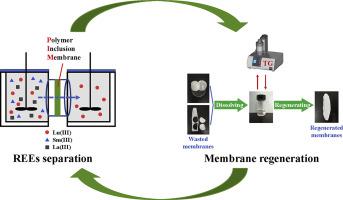Journal of Rare Earths ( IF 5.2 ) Pub Date : 2020-07-30 , DOI: 10.1016/j.jre.2020.07.024 Siyan Huang , Ji Chen , Dan Zou

|
This paper reports on the selective transport of Lu(III) from La(III) and Sm(III) through a polymer inclusion membrane (PIM) composed of 40 wt% di(2-ethylhexyl) phosphinic acid (P227) and 60 wt% poly(vinylidene fluoride) (PVDF). Basically, the changes in surface morphology, thickness and water contact angle of this PVDF-based PIM containing P227 (P227@PVDF PIM) with different polymer concentrations were investigated. By solvent extraction experiments, it is found that Lu(III) can be selectively extracted from La(III) and Sm(III) at pH 1.5 in hydrochloric acid solution. According to this result, P227@PVDF PIM was used to selectively transport Lu(III) from hydrochloric acid feed solution containing similar concentration of La(III) and Sm(III). The recovery factor of Lu(III) is 91% after 36 h, and about 5% of Sm(III) was also transported through the PIM. The concentration of La(III) in the feed solution and the stripping solution does not change. Furthermore, to overcome the ubiquitous decline of transport efficiency caused by the loss of carrier or the damage of membrane structure after long-term use of PIMs, a process for regenerating PIMs was first proposed and implemented. By comparison of the regenerated PIM with the normal PIM, there is almost no difference in the SEM image, ATR-FTIR spectrum and Lu(III) transport efficiency. It is expected that P227@PVDF PIMs have the potential to be applied to the grouped separation of rare earth elements (REEs), and this study also can be as an inspiration for the further study on the PIMs regeneration process.
中文翻译:

用于镥(III)分离和膜再生的聚合物包合膜的初步研究
本文报道了 Lu(III) 从 La(III) 和 Sm(III) 通过由 40 wt% 二(2-乙基己基) 次膦酸 (P227) 和 60 wt% 组成的聚合物包合膜 (PIM) 的选择性传输。聚(偏二氟乙烯)(PVDF)。基本上,研究了这种含有不同聚合物浓度的 P227(P227@PVDF PIM)的基于 PVDF 的 PIM 的表面形态、厚度和水接触角的变化。通过溶剂萃取实验发现,在pH 1.5的盐酸溶液中,可以选择性地从La(III)和Sm(III)中提取Lu(III)。根据这一结果,P227@PVDF PIM 用于从含有相似浓度的 La(III) 和 Sm(III) 的盐酸进料溶液中选择性地运输 Lu(III)。36 h 后 Lu(III) 的回收率为 91%,大约 5% 的 Sm(III) 也通过 PIM 传输。进料溶液和汽提溶液中 La(III) 的浓度不变。此外,为了克服长期使用 PIMs 后载体丢失或膜结构损坏导致传输效率普遍下降的问题,首次提出并实施了 PIMs 再生工艺。通过比较再生 PIM 与正常 PIM,SEM 图像、ATR-FTIR 光谱和 Lu(III) 传输效率几乎没有差异。预计P227@PVDF PIMs具有应用于稀土元素(REEs)的分组分离的潜力,该研究也可为进一步研究PIMs再生过程提供启发。进料溶液和汽提溶液中 La(III) 的浓度不变。此外,为了克服长期使用PIMs后由于载体丢失或膜结构损坏而普遍存在的运输效率下降,首次提出并实施了一种再生PIMs的工艺。通过比较再生 PIM 与正常 PIM,SEM 图像、ATR-FTIR 光谱和 Lu(III) 传输效率几乎没有差异。预计P227@PVDF PIMs具有应用于稀土元素(REEs)的分组分离的潜力,该研究也可为进一步研究PIMs再生过程提供启发。进料溶液和汽提溶液中 La(III) 的浓度不变。此外,为了克服长期使用 PIMs 后载体丢失或膜结构损坏导致传输效率普遍下降的问题,首次提出并实施了 PIMs 再生工艺。通过比较再生 PIM 与正常 PIM,SEM 图像、ATR-FTIR 光谱和 Lu(III) 传输效率几乎没有差异。预计P227@PVDF PIMs具有应用于稀土元素(REEs)的分组分离的潜力,该研究也可为进一步研究PIMs再生过程提供启发。为了克服长期使用 PIMs 后载体丢失或膜结构损坏导致运输效率普遍下降的问题,首次提出并实施了 PIMs 再生工艺。通过比较再生 PIM 与正常 PIM,SEM 图像、ATR-FTIR 光谱和 Lu(III) 传输效率几乎没有差异。预计P227@PVDF PIMs具有应用于稀土元素(REEs)的分组分离的潜力,该研究也可为进一步研究PIMs再生过程提供启发。为了克服长期使用 PIMs 后载体丢失或膜结构损坏导致运输效率普遍下降的问题,首次提出并实施了 PIMs 再生工艺。通过比较再生 PIM 与正常 PIM,SEM 图像、ATR-FTIR 光谱和 Lu(III) 传输效率几乎没有差异。预计P227@PVDF PIMs具有应用于稀土元素(REEs)的分组分离的潜力,该研究也可为进一步研究PIMs再生过程提供启发。ATR-FTIR 光谱和 Lu(III) 传输效率。预计P227@PVDF PIMs具有应用于稀土元素(REEs)的分组分离的潜力,该研究也可为进一步研究PIMs再生过程提供启发。ATR-FTIR 光谱和 Lu(III) 传输效率。预计P227@PVDF PIMs具有应用于稀土元素(REEs)的分组分离的潜力,该研究也可为进一步研究PIMs再生过程提供启发。











































 京公网安备 11010802027423号
京公网安备 11010802027423号